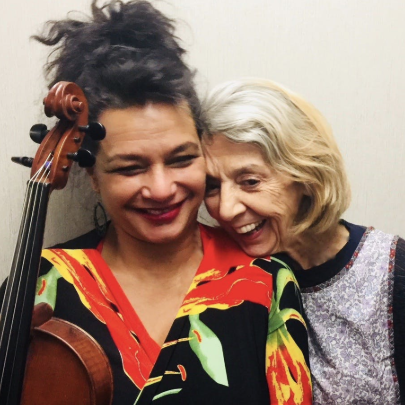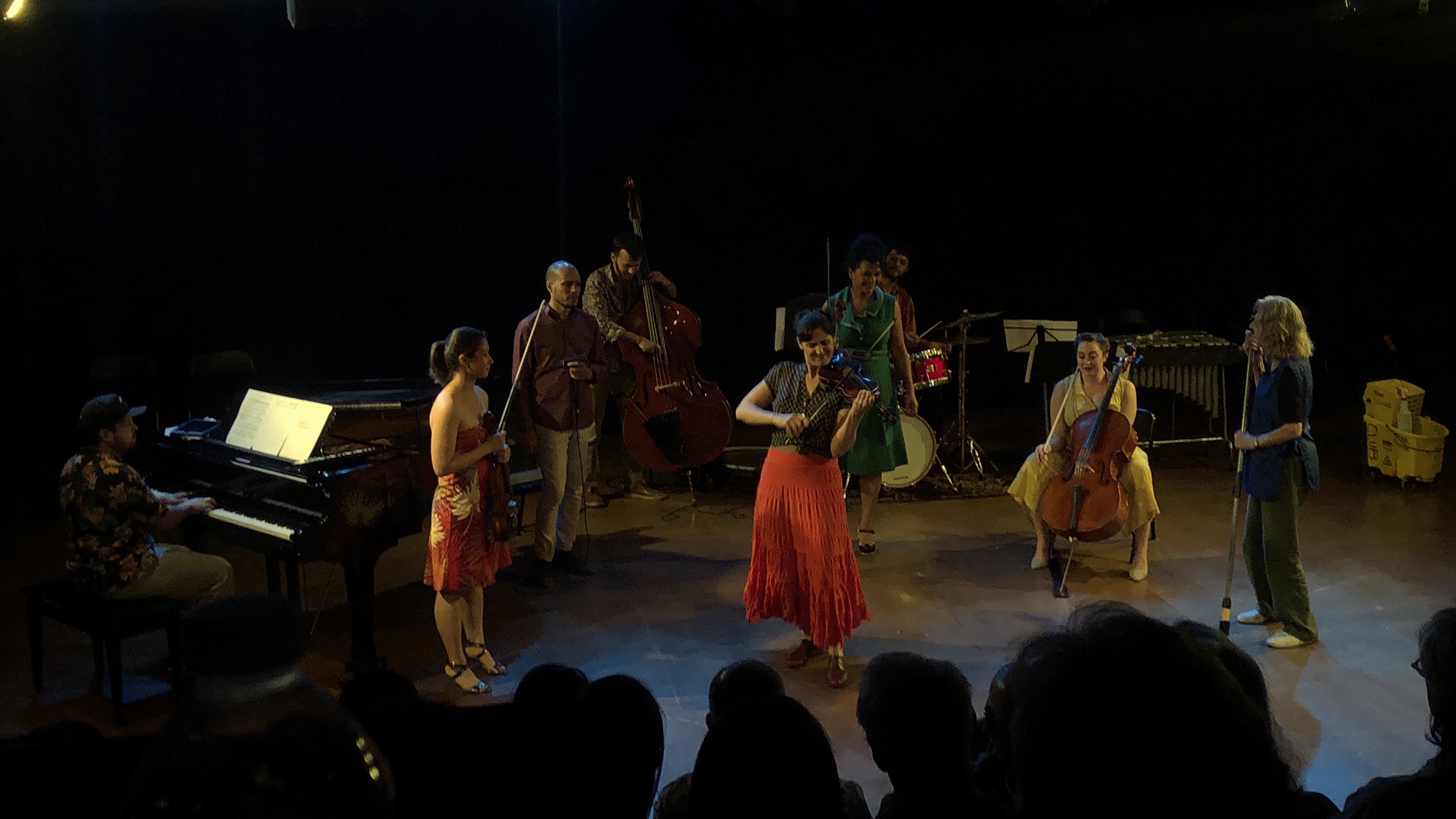La MaMa Experimental Theatre Club Presents Bach and Bleach in Review
Esther Apituley, Artistic Director/violist; Erwin Maas, Director (NYC Version); Text by Ko van den Bosch; Tamara Keasberry, Creative Producer; Bob Zimmerman, arranger;
Featuring Jenny Sterlin, actress; Emily Uematsu and Carolin Pook, violins;
Chanel Karimkhani, cellist; James Robbins, double bassist;
Carlos Horns, pianist; Grégoire Maret, mouth-harmonica;
Ethan Cohen, percussion;
Members of the NY Choral Society, Michael Ciavaglia, conductor
La MaMa Experimental Theatre Club, New York, NY
June 8, 2019
An extraordinarily beautiful production billed as a “Theatre Concert” took place at La MaMa Experimental Theatre Club last week (June 5-9), and it turned out to be much more than the promised “play with music”; It was more accurately a play about music and its restorative and unifying power – and in a broader sense a play about life in general.
From the very first scene, in which a character called Cleaning Lady finds herself vacuuming the stage, we are brought into a reality far removed from any glitz or glamor, the reality of bleach, mops, vacuum cleaners and anonymity. As this character herself remarks, “there has never been a review that says ‘very good cleaning lady’” – though her faceless state is corrected by the end, at which point (avoiding a spoiler) one might say that her face is celebrated everywhere.
Cleaning Lady is heartbreakingly lovable as played by actress Jenny Sterlin, and as we hear a bit of her story as a Bosnian refugee and learn her name, Maria, we gather that she has turned her years of suffering and loss into wisdom but has never quite experienced the music coming from the very stages she cleans. That all changes through the course of this play, and thankfully there is humor enough to render the pain endurable. As a small ensemble of single-minded musicians arrive for their concert, led by their violist, the dynamic Esther Apituley, an initial clash occurs, followed by a journey across barriers of all sorts as the characters realize the connections among themselves and their ability to “meet in music.” This whole scenario requires some “suspension of disbelief” as a drama, but the truth behind the drama requires none; in fact, it should resonate for anyone working in the arts or, from the other side of things, striving to experience them.
The “concert” itself – an assortment of over a dozen wide-ranging classical and jazz performances interspersed with dialogue – included music of Purcell, Handel, Bach, and others, featuring most prominently Bach’s Chaconne from the Violin Partita in D Minor, here played movingly and with profound involvement on viola by Ms. Apituley. If there is any thought that a performer involved in such experimental theater might be less capable as a solo musician than the typical concert artist, let that prejudice be banished. Ms. Apituley was musically top-notch, but beyond that she did what more musicians ought to do, which is to commit to every single moment with intensity. To do that – plus all the other classical and jazz ensemble work and drama – was a tour de force.
Also heard were the Caprice No. 24 of Paganini (though listed as his Etude No. 4) played commandingly by Emily Uematsu, the Intermezzo (fourth movement) of Shostakovich’s Piano Quintet in G minor, the Waltz for String Quartet of Benjamin Britten (from Three Divertimenti), and Fauré’s tender Berceuse, Op. 16. More info may be found at the production’s website: http://lamama.org/bach_and_bleach/, but kudos must go to all of the other commendable musicians, violinist Carolin Pook, cellist Chanel Karimkhani, double bassist James Robbins, pianist Carlos Horns, percussionist Ethan Cohen, and Grégoire Maret, who improvised impressively on mouth-harmonica.
Additional music included Cleaning Lady by Arnold Marinissen and some wonderfully played jazz arrangements of Bob Zimmerman, ingeniously incorporating motifs from the Bach Chaconne and the Paganini 24th Caprice. In addition, the song Bohémienne (from Notre Dame de Paris, by Cocciante and Plamondon) was sung by the evening’s cellist, Chanel Karimkhani, conveying soulfully again the very human state of wandering and uncertainty.
After the Shostakovich movement was played, Ms. Apituley briefly opened the discussion to the audience. To the question, “Did you see anything as you listened?” the responses ran the gamut – from colors to landscapes to family. From Maria, though, unaccustomed to concert music and paralyzed by the question, there was great fear of having “the wrong answer” – and this moment was exactly why this play could be so valuable to those inexperienced with concert music. The reassuring of Maria and what followed was a dispelling of preconceptions – and exactly what is needed by the world of live music today.
Such symbolic or didactic missions can tend to lend a two-dimensional quality to a theater piece – and indeed there were initial moments of stick-figure stiltedness in the first clashes of characters – but, as it soon was clear, that stiltedness provided a dramatic contrast with the naturalness developed later in response to the music and to each other. Thanks to the irresistible humor and humanity of Jenny Sterlin and some compelling musical advocacy by the musicians, particularly Ms. Apituley, the drama and music were powerfully alive and real.
There were layers of metaphor suggested in this play, including the convergence of notes in music relating to the convergence of individuals through shared experience – even a running theme about particles and waves, introduced through Maria’s recollections of long-ago dreams to become a physicist – and yet, all unfolded with naturalness and ease.
If one had one reservation about the evening, it was in regard to the program notes. When drawing the untutored listeners into classical music, it can be helpful to give complete program details, so that audience members can follow up on works they like. Many such traditions of classical concerts actually serve a purpose. As it was, we were told that there were no printed programs, but in an effort to “go green” the program info would be digitized, i.e. accessible on cellphones. Upon entering the hall then we were then told to turn off all cellphones.
The concept of Bach and Bleach sprang from text by Dutch author Ko van den Bosch. Direction for the NYC production was by Erwin Maas with Tamara Keasberry as Creative Producer. Esther Apituley is listed as Artistic Director, but clearly she is even more than that, on a mission to bring what she loves to the world.
Though I was surprised at first to see one young tween-ish boy entering the theater (with some fairly “adult” flyers within eyeshot), I wished by the end that every child in the world could see this play as part of their introduction to concert music. Bach and Bleach has been played over 50 times in Europe and is supported as part of the Dutch Culture USA program by the Consulate General of the Netherlands in New York (plus other donors), so perhaps there are still more benefactors out there to ensure that it gains ever greater audiences and numbers of performances.
Oh, and one more thing: very good cleaning lady.



